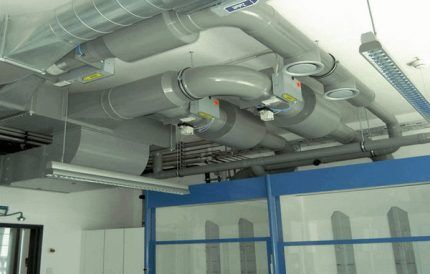Installation of plastic ventilation air ducts: a guide to constructing a system made of polymer pipes
With the development of the chemical industry, many metal structures were replaced by their polymer counterparts. When constructing individual low-rise buildings, the installation of plastic ventilation air ducts becomes a priority. Their technical qualities and technological advantages provide superiority over previously used options.
An untrained person will say that plastic releases toxic substances into the air and is therefore harmful to health. This article will help you to make sure that this is not the case at all, and that modern polymer materials have European certificates of quality and safety.
We will talk about the specifics of the design of a ventilation system made of polymer pipes. We will introduce you to the assortment and give recommendations on selection. Do-it-yourselfers will find information about wiring options and connection methods here.
The content of the article:
Materials for the production of plastic pipes
The construction market offers ventilation pipes made of several types of polymer materials.
The consumer is offered:
- Polyvinyl chloride (PVC) pipes can operate in a temperature range from -30O up to +70O Celsius. They are used primarily in domestic and residential construction for heated and cold rooms. PVC is a non-flammable, thermoplastic material, melting point 165-200 degrees. Good dielectric. The inside has a smooth surface. Does not tolerate frost well, at a temperature of 15O below zero it loses its properties.
- Fluoroplastic vent ducts (PTFE) have high heat resistance, withstand heating up to 260O Celsius. Air ducts are used to transport air mixtures with a high content of acidic and alkaline ingredients. Fluoroplastic is used in industry for the manufacture of high-strength ventilation networks.
- Air ducts made of polypropylene (PP) They are distinguished by their affordable price and are resistant to aggressive components of the air environment: acids, alkalis.
- Polyethylene pipes (PE or LDPE, HDPE) They are distinguished by lightness, flexibility, elasticity, but do not withstand negative temperatures well. The material is neutral and does not interact even with acids. Polyethylene does not emit harmful substances and is considered absolutely harmless.
Polyethylene pipes are designed for a long service life. The internal smooth surfaces offer virtually no resistance to air flows moving along them.
European countries have recognized PP as a technically obsolete material. You can still purchase air ducts made of polypropylene in the Russian retail chain.
The purchase of products made from this material for a residential building will be justified for use in utility rooms or when there is a lack of budget funds.
Assortment by standard sizes and section shapes
Most popular in residential construction PVC air ducts are available in two versions:
- round with cross-sectional diameters of 100 mm, 125 mm, 150 mm, 200 mm;
- rectangular with cross-sectional dimensions 55 × 110 mm, 60 × 122 mm, 60 × 204 mm.
The throughput capacity of round ventilation ducts increases with increasing diameter. The efficiency of a pipe with a diameter of 125 mm is 1.5 times higher than that of a pipe with a diameter of 100 mm, and the efficiency of a pipe with a diameter of 150 mm is already three times higher than one hundred square meters.
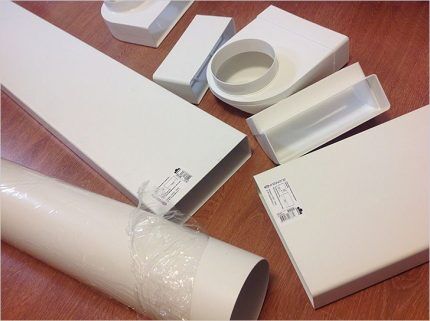
A 100 mm round duct works with the same performance as a 55 × 110 mm duct. A round duct of 125 mm and a rectangle of 60 × 204 mm are almost equivalent in air throughput.
The 200 mm round pipe is produced without a wide range of connecting parts. An air duct with a rectangular cross-section of 90 × 220 mm corresponds to a round pipe with a diameter of 150 mm, but is rarely used in practice due to its high cost.
Plastic pipes have gained credibility among private house developers due to such remarkable characteristics as:
- ability to absorb noise and heat;
- perfectly smooth surface allowing air to pass through the channel at high speed;
- lack of corrosion, making it possible to lay pipes in rooms with high humidity;
- indifference to aggressive influences, ensuring long-term operation;
- walls treated with antistatic agents, preventing the accumulation of electrical charges and dust settling inside the channel;
- sufficient strength and low weight;
- simple and understandable process for assembling large units and spatial systems;
- manufacturing of parts in accordance with GOST and TU with obtaining certificates for compliance with sanitary and hygienic requirements;
- relatively affordable price.
The disadvantages of PVC pipes include low fire resistance, fear of negative temperatures, and the need for antistatic treatment.
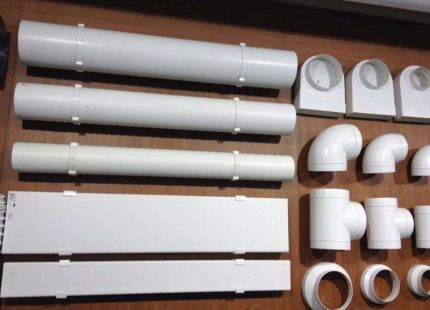
The white color of the plastic harmonizes perfectly with the decoration elements of the rooms; air ducts are often hidden behind drywall and then finished.
Low height polymer boxes helps reduce the space between the floor slab and the suspended ceiling. Thereby maintaining an acceptable height of the room and its cubic capacity.
Ventilation device made of polymer pipes
If certain rules are followed, installation of PVC air ducts is quick and easy. A significant role in this belongs to the methods of joining individual parts. We offer a huge selection of connecting parts: corners, bends, tees, plugs. If one part fails, it can be easily dismantled and replaced with a new element.
The use of thermal insulation shelters
In unheated rooms, polymer channels are wrapped with heat-insulating materials.Otherwise, the pipes will be covered with snow frost in winter.
The following are used as insulation:
- foamed polyethylene, covered with foil on one side and coated with adhesive on the other;
- a layer of rubber with the same coatings, this material is much more expensive than the first.
Before thermal insulation, the surface of the air duct is cleaned of dust deposits and dirt. The seams are sealed with a special foil tape.
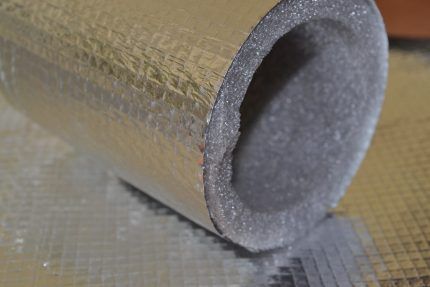
Cross-linked polyethylene heat insulator is made using a special technology that creates linear and transverse molecular bonds. The material is very durable, elastic, and does not lose its shape after squeezing.
Thermal insulation made of foam rubber has a microporous structure. The material is resistant to aggressive environments and retains heat well. It has a foil layer that prevents heat loss and provides sound insulation. Thanks to its high ignition temperature, it protects flammable materials from fire.
For thermal insulation of volumetric air ducts, especially when laying street routes, mineral wool slabs are used.
Design and preparatory work
Before starting design work, you should decide on the choice of ventilation system.
It comes in three types:
- supply and exhaust with air circulation due to natural gravity;
- supply and exhaust with mechanical stimulation of air flow;
- combined using the first and second types.
Natural air circulation depends on weather conditions.In the hot season, when the temperature inside the house and outside is equalized, it is necessary to turn on the suction force by installing electric fans in the ducts. There are devices on sale that are designed for installation in a ventilation system made of polymer plastic.
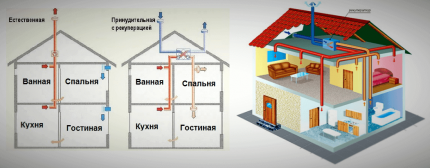
Installation is carried out according to a pre-developed ventilation project. The complex structure of the ventilation complex will require contacting professional designers who will tell you how to assemble a plastic ventilation system.
For accurate calculation of air duct area and their location you need to have a certain set of knowledge. Take into account established standards and make calculations using a specific algorithm.
It is possible for a person who is able to independently study the basic norms and rules of design to complete working drawings of a simple ventilation installation on their own.
Calculation of the cross-section of air ducts
To calculate the parameters of the ventilation system elements, you should follow the instructions of SP 54.13330, SP 60.13330, SanPiN 2.1.2.2645.

There are three calculation methods available:
- according to the number of complete air turnover in the room in 1 hour;
- according to sanitary requirements;
- by total area of rooms.
The air exchange rate for living rooms is 1 time/hour.
Kitchen with 4-burner gas stove – 90 m3/hour plus additional 100 m3/hour.
Kitchen with electric stove – 90 m3/hour.
Bathroom, toilet – 25 m3/hour.
Room with a solid fuel boiler – 1 + 100 m3/hour.
Boiler room with gas unit – 3 + air volume for fuel combustion.
Calculation algorithm based on air circulation rate
To determine the diameters of air ducts, find the standard hourly air flow for each room and for the inflow and outflow in the system as a whole:
- The volume of air in each room will be equal to its cubic capacity. To determine it, multiply the length of the room by the width and height.
- The standard values of air turnover for each room are taken into account and the hourly air flow is determined.
- The results obtained are rounded up and summarized separately for air inflow and air removal.
- Maintaining a balance between air inflow and outflow is the basis of the calculation.
- The resulting total hourly air flow rates are used to determine the size of the main supply and exhaust ducts.
- Set by the required air speed - 3-4 m/sec.
- Using diagrams in regulatory reference books, find the required pipe diameter.
- Using special tables you can also find a box of equivalent cross-section.
Working drawings and a diagram will tell you how to assemble a plastic ventilation system in accordance with the designed capacity. They perform it independently according to the calculation data.
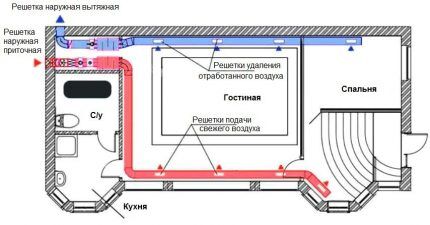
Specific locations of ventilation ducts are marked, center lines are drawn, and air duct attachment points are marked. The presence of drawings ensures accurate marking of the passage of ventilation ducts, punching holes in walls and ceilings.
Connecting fittings and installed equipment
To connect straight parts into a spatially branched network, standard fittings are used:
- check valves;
- tees - a fitting with three holes, connects two parts of the main channel, a side branch is connected to the third outlet;
- crosspieces - for connecting two side branches;
- adapters from a round pipe to a rectangular one, from one size to another;
- bends for turning the ventilation duct;
- couplings;
- plugs and grilles.
A check valve in the ventilation ducts controls the movement of air in the desired direction. It does not allow reverse thrust to appear. Design check valve is very simple: the blade opens when the air flow moves in the direction established by the design, and when moving in the opposite direction, it closes the passage of the channel.
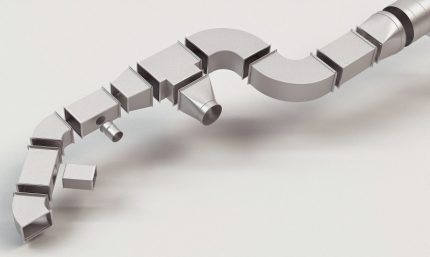
Filters are installed on the supply air ducts to remove dust and small debris.If there is a lack of natural flow of fresh air through the windows and vents in the walls of the building, install supply valves.
Due to the difference in pressure inside and outside the building, street air will enter the room in gravity ventilation networks. However, its work may be interrupted in the summer, when the pressure outside the window and in the room equalizes. To create a stable ventilation system that does not depend on weather conditions, supply or exhaust fans are installed in the ventilation duct system.
To heat the supply air during the cold season, install recuperators. The principle of their operation is to transfer the heat of the removed air flow to the newly received air volume.

A separate exhaust duct is installed for the exhaust from the kitchen stove. Ventilation grilles in rooms are equipped with check valves. The technological process performed by a team of professional installers is not much different from installing plastic ventilation with your own hands.
The procedure outlined below for creating a ventilation system for a private home can be considered a guide to action for those who like to do everything on their own.
Installation of a ventilation complex made of polymer pipes
At the preparatory stage, the entire range of parts is prepared according to the design specifications.For insurance, the supply of fittings and fasteners is increased by 10 percent.
You will need a simple set of tools:
- for cutting plastic pipes and boxes, a hacksaw for metal or wood; to speed up the work, a small grinder saw;
- hammer drill for drilling holes in walls and ceilings;
- sandpaper, glue, sealant, mounting tape;
- tape measure, marker;
- screwdriver
They begin work by assembling larger units, using the entire arsenal of shaped parts. The main element of the assembled modules and air ducts is a straight duct or pipe with standard dimensions. Round pipes and rectangular PVC boxes have a length ranging from 0.35 to 2.5 meters.
For even cutting, an exact cutting line is drawn on the surface of the box or pipe. You can use a laser tool. They cut strictly along the intended line. After cutting, smooth ends remain without burrs or roughness.
A large section is applied to the wall or ceiling, the connection and fastening points are specified and fixed in the design position.
When routing pipes, it should be taken into account that each angle of rotation reduces the efficiency of the system. The shorter the total length of the air ducts, the higher their performance. To lay air ducts in a private house, it is better to use straight parts 2.5 meters long so as not to make unnecessary connections.
The air speed in channels with a round cross-section is higher than in rectangular boxes. But to save space, flat boxes are more often used.
To protect against condensation, drainage holes are made in the pipes. To remove dew drops, horizontal channels are given a slope of 0.01-0.015.
The kitchen hood is connected to exhaust duct using an adapter from round to rectangular cross-section. The connection point is sealed with silicone mastic.
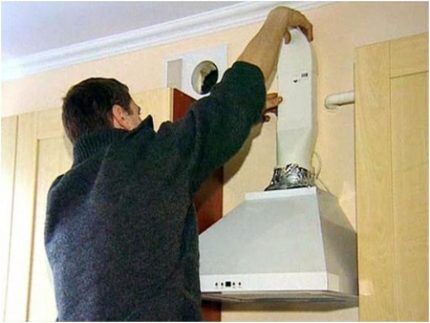
To pass through the wall, the duct is placed in a coupling. The channel outlets are covered with decorative grilles. The sag of the air duct should not be more than 50 mm.
Layout of ventilation ducts in a low-rise building
Using the example of a typical residential building, you can learn how to assemble a ventilation system made of PVC plastic.
In a two-story cottage with a standard set of rooms, it is necessary to lay one vertical exhaust duct with tees for connecting side outlets to the living rooms. This plastic duct will transport stuffy air from the bedrooms and living room into the attic space.
Nearby, the same supply duct descends from the attic to the first floor with the distribution of side branches through the fresh air supply zones to replace the remote air.
There are two air ducts for the kitchen:
- a separate exhaust duct for exhaust above the stove, going from the first floor to the attic;
- normal exhaust duct.
Autonomous exhaust ducts are extended into bathrooms to remove fumes from the bathroom and air from the toilet.
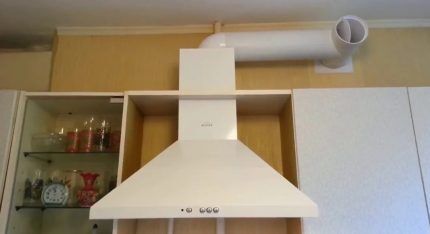
The range of connecting parts for plastic air ducts includes round-shaped plastic holders for attaching pipes to a flat surface.
For boxes, rectangular fastenings of appropriate sizes are provided.
Installation process:
- A hole is drilled in the wall or ceiling using a hammer drill:
- holders or brackets are secured using dowels and self-tapping screws.
Plastic fasteners work like latches, tightly gripping the element being secured. Metal plasterboard hangers can be used as ceiling mounts.
On air ducts running under the ceiling, tees and outlets are also installed to supply or remove air from different areas of the residential building.
All ducts are led to the attic and there, using flexible round air ducts, they are connected to the internal unit of the system. Adapters for connecting attic round pipes are placed under the ceiling of the top floor.
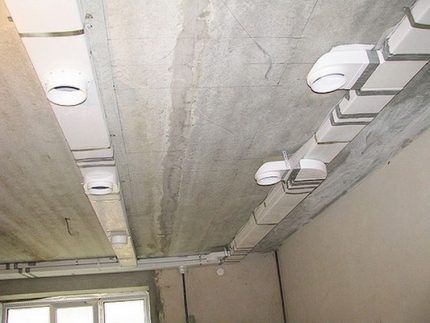
Depending on the chosen ventilation method, one powerful device is placed in the attic, providing exhaust and air flow throughout the entire house, or fans are placed in each air duct.
In a cold attic, pipes must be insulated. The height of the ventilation ducts relative to the roof ridge is determined as follows: in the drawing, a horizontal straight line is drawn from the roof ridge, and another beam is drawn from it 10 degrees upward.This will be the reference height for the removal of ventilation pipes. If the distance from the roof ridge to the ventilation pipe is less than 150 cm, it rises 50 cm above the roof ridge.
Silicone sealant for sealing seams is white in color and retains elasticity when dried. For more reliable sealing, metallized tape is used.
For better air circulation, free space is left below in the doors of the rooms.
Methods for connecting plastic pipes
Polymer pipes are connected to each other in several ways:
- using a coupling put on or inserted into the pipe;
- thermistor fittings made of special polyethylene with a metal spiral;
- butt welding using welding equipment.
The thermistors are heated using electric current, the polymer melts, and a welded joint with a high degree of tightness and strength is obtained.

When butt welding, plastic surfaces are pressed tightly against the heating element, then connected with a confident movement. The result is a welded seam that is not inferior in strength to the base material.
In self-assembly, it is recommended to use the simplest option for connections - couplings. To install them you will need soldering iron for polymer pipes, the so-called “iron”. For one-time work, it is more practical to rent it.
Regulatory requirements for laying ventilation pipes
Compliance with regulatory requirements for connecting air ducts to walls and ceilings, to each other, and to utility networks will allow installation without problems and troubles during expert acceptance of the work.
The distance between fastenings is no more than one meter. Contact with metal parts of the suspended ceiling is avoided so that noise and vibration are not transmitted to it.
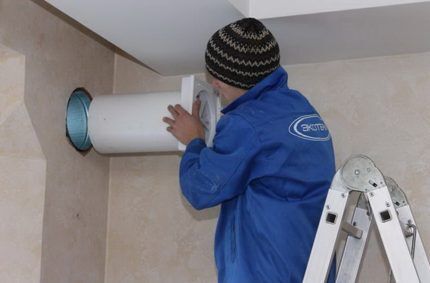
The vertical deviation of the channel is allowed no more than 2 mm per 1 meter of pipe.
The minimum distance to utility networks is 250 mm. To the electrical wiring - at least 300 mm.
The smallest distance between two round air ducts is 250 mm. Detachable connections are placed at a distance of at least 100 mm from the places of passage through walls and ceilings.
It is allowed to combine the channels of the bathroom, toilet, and technical rooms with the installation of check valves.
The use of plastic pipes for heating boilers and fireplaces is prohibited.
Even an inexperienced craftsman with a minimal set of tools can assemble plastic elements into large blocks and spatial structures. This applies to ventilation systems with natural air circulation without the installation of special complex equipment and automation units.
To build a complex system with the installation of ventilation equipment, recovery units, control units, you may have to seek help from installers from an organization specializing in the assembly of ventilation and heating systems.
In any system, even the simplest one, accurate calculation of parameters, availability of working drawings or diagrams for the placement and fastening of air ducts, and installation of ventilation equipment are important.
Conclusions and useful video on the topic
The video clearly demonstrates how exhaust and supply ducts are laid in the kitchen and bathrooms. The installation locations of check valves and electric fans are shown. The necessity of their installation is explained:

To summarize, we can say that the list of advantages of polymer pipes far outweighs their disadvantages. This is a decisive point in choosing the material for installing the ventilation system.
The lightness of structures, unification of parts, and simple installation have brought plastic air ducts to the forefront in the equipment of low-rise residential buildings, household and technical premises, and low-rise public buildings.
Tell us about how you installed plastic air ducts at your own dacha or in a country house, how you assembled a duct for connecting an exhaust hood in the kitchen. Share technological features that may be useful to site visitors. Please leave comments in the block form below.
